Did you know that the original Secret Of Monkey Island didn’t do that well commercially? It’s true; it sold strongly in Europe but these were offset by poor sales in the larger US market, and so it was only a moderate success. If LucasArts had known that ahead of time it’s likely that Monkey Island 2 never would have been made, but fortunately publishing and distributing a game on a global scale took much longer back in the 90s and so Ron Gilbert and co. jumped straight into the development of Monkey Island 2 after they finished Monkey Island 1, with no idea of how well the first game had sold because it hadn’t even made it to stores yet. This approach had its good and bad points; on the one hand we got a Monkey Island 2, but on the other the developers going head-first into a sequel meant they didn’t have time to critically assess why the first one worked and why people liked it.
Consequently Monkey Island 2 is a much more uneven game than its predecessor. This wasn’t helped by the development being wrapped up in less than a year — standard practice for LucasArts adventures at the time, but finishing one pirate-themed comedy adventure and going straight into another pirate-themed comedy adventure means a repeat visit to the same creative well, and at times Monkey Island 2 does feel like it’s pulling up the absolute dregs of the ideas that were passed over by the original for whatever reason. Its puzzle logic is far less, well, logical, with the game now devoting its conversation system almost entirely to comedy and offering far less in the way of direction compared to Monkey Island 1, and plenty of interactions and solutions that the game doesn’t even hint at (good luck figuring out that you can pick up the dog…). It lurches back to the bad old days of “use everything on everything” puzzle design at several points and is far less careful about compromising on its puzzles in the name of cracking a stupid joke. I found Monkey Island 2 to be a bit of a slog, all in all, and this surprised me because prior to playing it for this series I’d actually considered Monkey Island 2 to be the better of the first two Monkey Island games. That was an opinion helped along by the fact that I played it first, and didn’t get around to playing the original until a couple of years later — and thanks to some important technological improvements the mechanical process of playing Monkey Island 2 does feel much nicer.
The most obvious difference is that the EGA colour palette has finally been ditched entirely, with Monkey Island 2 using VGA art as standard; it does technically have an EGA version, but this is simply a filter applied on top of the VGA artwork rather than anything custom-drawn, and it looks absolutely terrible. The EGA art of the previous games really grew on me over time, but the artists were working in a style dictated by the limitations of the technology and it’s really cool to see them be able to cut loose and draw the things that they want to draw in all of their 256-colour glory. Large parts of Monkey Island 2 resemble a slightly pixelated1 comic book come to life; the backgrounds are much more obviously drawings now instead of pixel art — you can see the pencil/brush strokes in places — and this even has some pleasant consequences in terms of readability because most of the items you can pick up or interact with are still pixel art and have an obviously different look from the rest of the environment. Certain areas such as the beach where the game starts, most of Woodtick, and the voodoo swamp must have looked absolutely stunning to an audience previously used to a diet of EGA colour back in 1991, and still look pretty great today. The range of character animations has also been expanded, with Guybrush now having a vast range of unique animations for nearly everything in the game. They possibly go a little too far with the comedy cartoon effects — comically bulging eyes, heads staying in place while the rest of the body falls off a cliff, Guybrush’s hairpiece coming off and doing somersaults through the air on three separate occasions – and I think that’s something much more suited to the wacky style of Day Of The Tentacle and is a little incongruous here.
(That’s a bit of a theme with Monkey Island 2, though, as we shall shortly see.)
Monkey Island 2’s audio has received improvements to match the visuals, too, thanks to better sounds in general, a much greater volume of music compared to the original (practically the entirety of Monkey Island 2 has musical accompaniment now) and also a great innovation from Michael Land and the LucasArts team: the iMUSE system. The town on the game’s starting island, Woodtick, shows this off the best; the Woodtick theme is consistent throughout, but as Guybrush moves from screen to screen within Woodtick the theme dynamically changes to layer in different instruments that give each area its own unique feel. It’s leveraged a little less heavily afterwards, sadly, mostly being used to seamlessly segue between different music tracks instead of between different versions of the same track, but the Woodtick theme remains the game’s great musical accomplishment and iMUSE itself was used to great effect in later LucasArts adventure games such as Day Of The Tentacle and The Dig, and even in some non-adventure games; the way TIE Fighter leverages iMUSE to play different musical stings that highlight in-mission events contribute significantly to it feeling like a proper Star Wars game.
Lastly, the interface has also received a full overhaul. The selection of action verbs is further reduced to nine with the long-overdue demise of TURN ON and TURN OFF, and this lets them make the interface a bit more attractive by turning the verbs into a 3×3 grid of buttons. It also frees up the space needed to switch to a visual inventory, with each inventory item represented by a chunky icon instead of a simple list of words. This isn’t leveraged for humour quite as much as I’d like; it has a good one at the start with Guybrush starting the game with huge piles of money, cash and treasure visible in his inventory, and then immediately getting mugged by Largo which causes all of it to disappear. Otherwise the closest Monkey Island 2 gets is the absurd illustration of Jojo — but it’s certainly much more pleasing on the eye, not to mention allowing eight items on screen at once instead of six. However, the move to static buttons and icons does mean that it’s more difficult to do that interface-subversion humour that I enjoyed so much in the original Monkey Island; I don’t think Monkey Island 2 ever does anything clever with it, preferring to rely solely on its in-game jokes, and these are significantly more hit and miss than Monkey Island’s.
I think that where Monkey Island made the right choices around balancing the comedy with being a good adventure game — using the conversation system to give the player hints at the same time as cracking jokes, deliberately avoiding specific pop culture parodies so that the humour was more universal, and reducing the amount the player has to keep in their head at once by restricting things to a single island at a time — Monkey Island 2 makes all of the wrong ones. It goes all-in on the comedy at the expense of the actual game, and while it’s still pretty funny there’s been a subtle shift in the tone of its humour that means certain elements of it have aged particularly poorly. Take the monkey wrench puzzle: there’s a pump off in the middle of nowhere that Guybrush can’t turn on, and Guybrush doesn’t have anything in his inventory that looks like it will obviously do the job. Most adventure games would have you picking up a pump handle, or using a makeshift lever, or something that makes logical sense. The first Monkey Island would have dressed it up with a little bit of absurdist humour, like the rubber chicken with the pulley in the middle, but the general use of the item would still be pretty clear. Monkey Island 2, however, decides to base this puzzle entirely around a terrible pun with no logical root in the real world, or the game one: you have a monkey called Jojo in your inventory, and using him on the pump allows Guybrush to turn it — because he’s a monkey wrench, get it? Not only is this a puzzle that makes some very specific assumptions on the part of the player — that they speak English (in order to get the pun) and that they know what a monkey wrench is — but it’s not actually a thing predictable by them, because only in a cartoon would you be able to use an actual, living monkey as a wrench. If you don’t have that information and you’re not able to get inside the designers’ head like that, the only way you can solve this puzzle is by using every single item in your inventory on the pump until you find one which works. All in the service of a not-particularly-good joke.
This isn’t a fair example of most of the puzzles in the game, but it’s a fair example of a lot of them: logical outcomes have been replaced either by joke ones or by my old enemy, Adventure Game Logic. Late in the game you need to win a drinking contest with a pirate by switching the real grog he gives you with non-alcoholic grog. The bartender in Woodtick tells you he sold the last of his to Kate Capsize, who is currently trying to sell trips on her glass-bottomed boat on Booty Island, and she won’t give you any. How, then, do you get this grog? Well, the answer is very simple: there’s a Wanted poster for Guybrush up on a wall on Phatt Island, complete with a little ten by ten pixel doodle of Guybrush’s face. The flyer Kate gives you for her boat trips has a little ten by ten pixel doodle of her face on it. This is all the help Monkey Island 2 gives you to indicate that you’re supposed to use the flyer on the wanted poster, which will cause Guybrush to paste Kate’s face over his own. What this achieves is not immediately obvious, and only becomes apparent once Guybrush leaves the area:
- Kate turns up on Phatt Island, having sailed all the way over there from Booty Island (no other characters in the game move around like this).
- A guard accosts her, mistaking her for Guybrush, and puts her into the Phatt Island jail.
- Guybrush can then go and collect her possessions, which have been decanted into a vanilla envelope and which consist solely of the non-alcoholic grog.
Again, I ask you: how on earth are you supposed to figure out that this will happen? There’s another good one where you win the spitting contest (an actually good puzzle, despite certain dissenting opinions to the contrary) and all you get for your trouble is a cheap prize plaque. You’re supposed to take this to the nearby antiques dealer and convince him it’s incredibly valuable and get the seed money to hire Kate’s boat, but this is another instance where the only way this interaction would become apparent is if you went through your entire inventory and tried to sell everything to the antiques dealer.
Enough of Monkey Island 2 is like this to make playing it significantly more of a slog than going through Monkey Island’s admirably directed puzzles. It’s not helped by its structure, either, which is much more non-linear: the bulk of the game happens in Part 2, where you can travel between three islands at any time with the puzzle chains spread across multiple islands at once, despite the player’s brain — and the game, via loading screens — creating mental disconnects between each set of locations. This makes it much harder to keep everything in your head at once; if you got stuck in Monkey Island you could just go to the map of Melee Island and look at the location names to jog your memory, but in Monkey Island 2 you don’t have that easy reference for remembering what’s at a given location without going there. Perhaps I’m still coming at it from too modern a perspective; perhaps it’s unfair to tackle these games without keeping a copious amount of notes just like I would have back in the 90s. Still, it’s fairly damning that I actually needed a walkthrough to complete Monkey Island 2 despite having played it more often, and more recently, than the original game.
And then there’s the game’s infamous ending sequence, where (and I suppose I should drop in a big SPOILER WARNING here, although the game is twenty-nine years old now so you have no excuse for not having played it already) Guybrush finds the treasure of Big Whoop and immediately falls through the floor into a set of underground tunnels that are revealed to be the staff corridors in a pirate-themed amusement park. Guybrush turns out to be a small child playing at being a pirate, while his nemesis LeChuck is actually his older brother, Chuckie. This is partly an excuse for them to make a load of Star Wars pop culture references — “I am your brother!”, “…remove my mask…” etc. — that have aged like milk thanks to an additional 29 years where the internet has run those references straight into the ground. (Monkey Island 2 does this a lot, with multiple Indiana Jones references scattered throughout the game.) Mostly, though, it’s just Ron Gilbert hitting you over the head with the joke that he’d previously just assumed you understood and which worked because it was taken as a fait accompli that didn’t need explaining: that the world of Monkey Island was inspired by pirate theme parks and was deliberately set up to resemble one, so wouldn’t it be hilarious if it actually turned out to be one? As usual foregrounding the joke makes it far less funny, and I’m staggered that this was where the story ended until Curse came out in 1997 and partially retconned it.
None of this is to say that Monkey Island 2 is a bad adventure game. It’s still obviously made by the same team behind Monkey Island 1, and their talent shows through despite all of these poor decisions. It is a self-indulgent one though, a game which is much more desperate to show you how clever it is and how funny it is, and which will hit you over the head with its jokes in search of a belly laugh where its predecessor would have settled for a wry chuckle. I think my previous good opinion of it was partly because I first played it when I was 12 and all of these things would have been very, very funny to me; replaying it as an adult, it just seems a bit tired, and not at all worth compromising on the story and the puzzles for. Unlike the first game, which turned out to be a moderate commercial success, Monkey Island 2 was a commercial failure and the franchise was shelved until a surprisingly strong long tail of sales and an increasingly large cult following caused LucasArts to bring it back for the last hurrah of the 2D adventure game in 1997. That was probably something of a blessing in disguise, since Monkey Island 2 is just good enough that the series escaped with its dignity intact and they had some time to figure out what they wanted to do for the third one. Had LucasArts continued along the trajectory set by Monkey Island 2, though, I think that the Monkey Island series as a whole would be nowhere near as well-regarded as it is today.
- The number of colours may have increased by a factor of 8, but the resolution is still the same. ↩

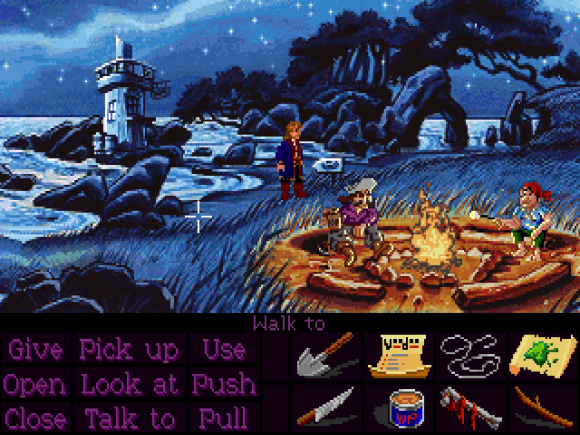
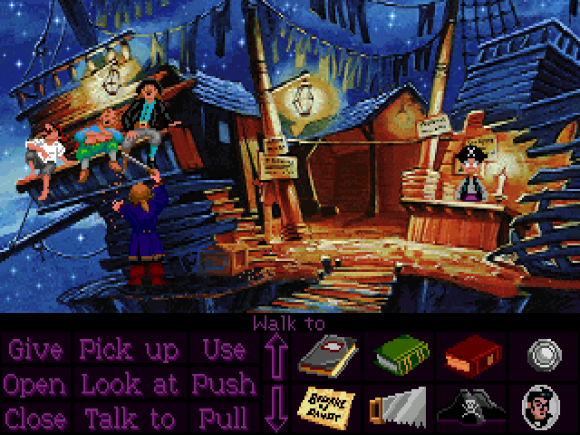
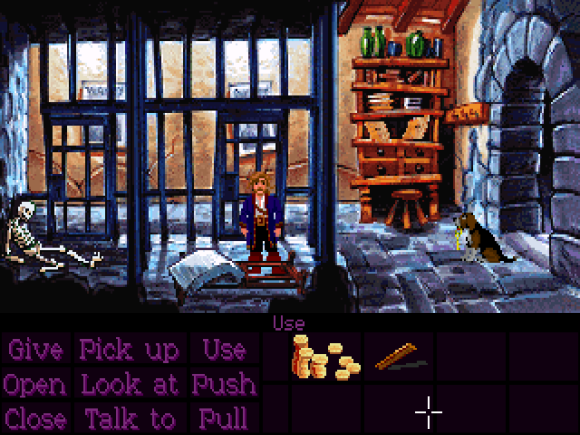
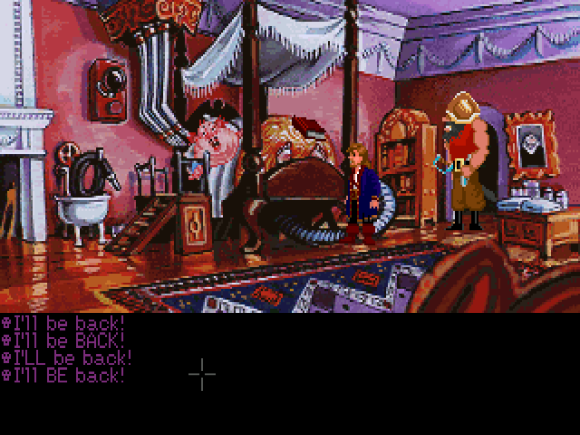
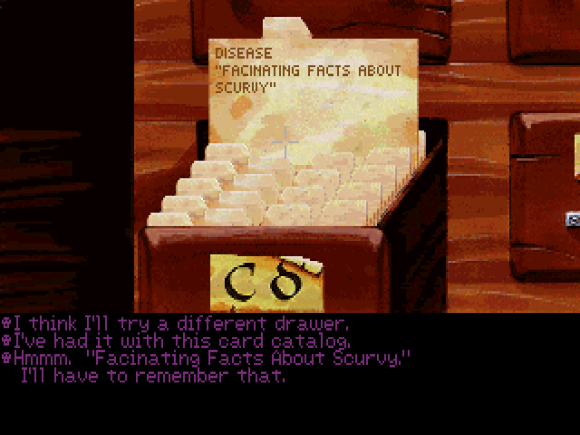
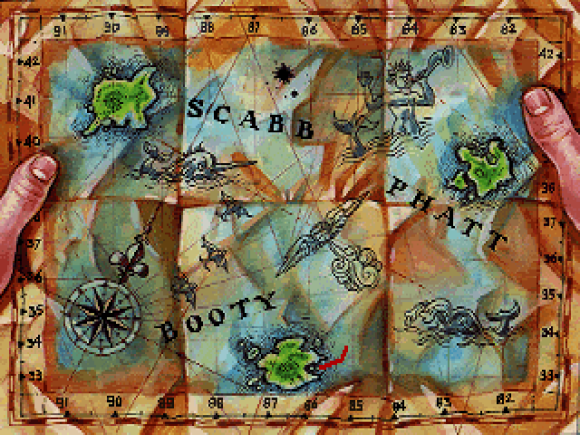
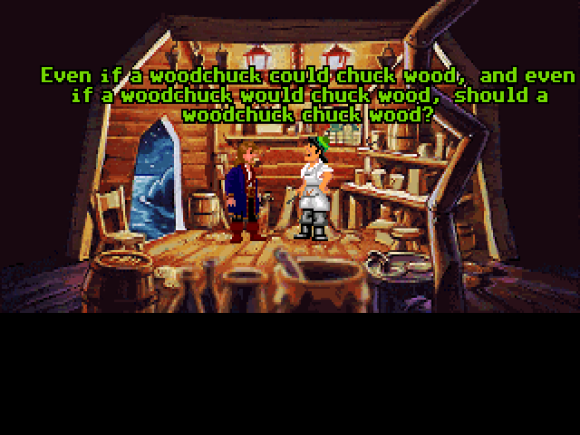
I appreciate someone else finding LeChuck’s Revenge overrated. I only played it after Curse and found it kind of a letdown given its sterling reputation. The ending in particular has been lionized; “if only Ron Gilbert had gotten to make the next game, we’d all have recognized its brilliance!” Nah. I can’t imagine a situation where it would pan out given how strange and meta it is, and the next two games would both struggle in the attempt to explain it away.
The monkey wrench puzzle took a *lot* of tries for me to figure out as a spanish-speaking young teen in the mid 90s. I didn’t understand the joke until much later, thanks to a certain Foo Fighters song.
I *did* hate the monkey wrench puzzle, certainly. The wanted poster didn’t give me any significant trouble, though. I admit that the outcome isn’t predictable following any sort of rational real-world logic, but by the standards of adventure games, it’s not wildly disconneted.
I think a lot of this is just our modern sensibilities. MI2 was clearly meant to be harder than MI1, and that includes spreading its puzzles across multiple island. The monkey wrench is indeed a mistake and Ron admits as much. In general, I enjoy the atmosphere of MI2 far more than I do MI1′s.
I completely agree with you regarding the ending though. It’s self-indulgent to a ridiculous degree, and almost certainly a result of Ron having written himself into a corner. The amazing thing is that he repeated this exact same mistake 20 years later with Thimbleweed Park.
Thimbleweed Park and Return to Monkey Island had terrible endings too. Gilbert should just swallow his pride and collaborate with story tellers (surely he had connections with Lucas Film?)
I recall being wowed with 12 disks when I opened MI2. I had this and Fate of Atlantis on the Amiga, which also had more disks, but I recall that MI2 had far fewer disk swaps whereas Indy required constant changes.
I think I enjoyed the length of MI2 and having played both again recently I feel both the original and sequel have their strengths. I think that MI2 having more daytime locations really showed the colour and artwork.
Storywise I think it was good that MI2 moved away from damsel in distress with Elaine and was a piratical treasure hunt. And yes some puzzles were confusing but I found some in MI1 the same, and I appreciated that it was a bigger game. More monkey puzzles = more fun, even if those puzzles and jokes weren’t as strong.